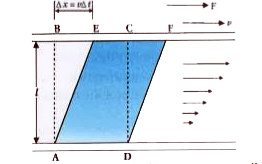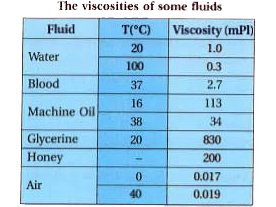Discuss coefficient of viscosity in the contex of stress and strain .Solution in Gujrati
In figure laminar flow of liquid is shown.

A layer of liquid sandwiched between two parallel glass plates in which the lower plate is fixed and the upper one is moving to the right with velocity v
Liquid layers are shown between the glass plates .
Upper plate move with velocity v hence layer contact with it also move with velocity v.
On account of this motion , a portion of liquid, which at some instant has the shape of ABCD, take the shape of AEFD after short interval of time Δt.
During time ,the liquid has undergone a shear strain of Δxl .The strain in a flowing fluid increases with time continuously.
In this case , the stress depend on the rate change of strain or stress depend on the rate change of strain or strain rate , that is ΔxlΔtorvl
instead of strain itself. (Here ΔxΔt =velocityv)
Here shearing stress is FA . Where A is the area of contact surface and F the viscous force F in the direction of tangent.
For fluid ,
coefficient of viscosity =η=Shearing stressShear strain
∴η=(F/A)(v/l)=FlvA ....(1)
OR
F=ηA(vl) ....(2)
The SI unit of viscosity is poiseiulle (Pl).
1 poiseiulle 1Nsm−2=Pa⋅s
CGS unit of coefficient of viscosity is poiseiulle
1 poiseiull =1 dyne S cm−2
1 poiseiulle =10 pois
The dimensions of viscosity are [M1L−1T−1] Generally thin liquids like water , alcohol are less viscous then thick liquids lke coal tar , blood, glycerine etc.
The viscosity of liquids decreases with temperature while it increases in the case of gases.

Topper's Solved these Questions
- BOOK - KUMAR PRAKASHANCHAPTER - MECHANICAL PROPERTIES OF FLUIDS EXERCISE - SECTION-A Try Yourself (VSQs)132videos
MECHANICAL PROPERTIES OF FLUIDS
- BOOK - KUMAR PRAKASHANCHAPTER - MECHANICAL PROPERTIES OF FLUIDS EXERCISE - SECTION - B Numericals29videos
MECHANICAL PROPERTIES OF FLUIDS
- BOOK - KUMAR PRAKASHANCHAPTER - MACHANICAL PROPERTIES OF SOLIDS EXERCISE - QUESTION PAPER11videos
MACHANICAL PROPERTIES OF SOLIDS
- BOOK - KUMAR PRAKASHANCHAPTER - MOTION IN A STRAIGHT LINE EXERCISE - QUESTION PAPER11videos
MOTION IN A STRAIGHT LINE
Similar Questions
What is fluid ?
07:17View SolutionA 14.5 kg mass, fastened to the end of a steel wire of unstretched 1.0 m, is whirled in a vertical circle with an angular velocity of 2 rev/s at the bottom of the circle. The cross- sectional area of the wire is 0.065 cm2. Calculate the elongation of the wire when the mass is at the lowest point of its path.
02:49View SolutionWhat is called brittle material ?
03:00View SolutionDefine frame of reference and give its types.
50:47View SolutionSTRESS-STRAIN DIAGRAM
46:01View SolutionStress to strain ratio is equivalent to
05:02View SolutionStress & Strain
04:06View SolutionElasticity: Longitudinal Stress & strain | Shear stress & shear strain | Volumetric stress and strain
34:12View SolutionStress And Strain|Hookes Law#!#Stress Strain Curve
05:14View SolutionExplain hydraulic stress, volume stress and volume strain
04:31View SolutionStress & Strain
01:01:50View SolutionStress Strain Diagram
03:56View SolutionOn gradual loading , stress - strain relationship for a metal wire is as follows . Within proportionality limit , stress prop strain or, "Stress"/"strain" = a constant for the material of wire. If "Stress"/"Strain" is x in elastic region and y in the region of yield , then
View SolutionDiscuss about stress-strain curve .
View SolutionNormal Force|| Stress and Strain
03:29View Solution

